Y.I.Shirokova,
A.N.Morozov
Central
Research Institute of Irrigation (SANIIRI) after V.D.Jurin
ON
MOISTURE-CHARGING IRRIGATION ROLES IN INCREASING WATER SUPPLY TO IRRIGATED
LANDS
(The article was published in the full form in the Water Resources
of Central Asia collection. Almaty, 2002, pp.312-320)
Operation
mode change of the cascade of over-year-regulation-reservoirs in the
Syrdarya river basin and, partly, in the Amudarya river one taking
place last decades owing to their transition from the irrigation to
energetic discharge schedule causes some tension when carrying out
vegetative irrigation, especially in mean and low water years. Agricultural
producers experience considerable lack of irrigation water during
most dry and hot vegetation months - June and July. How to plot an
optimal scheme of crop irrigation in order to mitigate irrigation
water deficit in these months (it is desirable without crop loss)?
The
article does not touch upon the water economy question applying antifiltration
measures in canals, efficient methods of irrigation technique and
technology those are big, very important, and independent issues;
but this is completely devoted to ways of forming soil water-salt
regimes using techniques available at the farmer's disposal: regulation
of irrigation terms and rates.
Farmers'
experience in irrigation canals taking water from small rivers, flood
of which happens in early spring and ends in the very beginning of
summer, indicates necessity in making moisture-charging and on salted
lands preventive moisture-charging irrigation. When is it more efficient
and economical to conduct such arrangements in republic's diverse
climatic zones under conditions of altered (to energetic) reservoirs
operation schedule? What is effectiveness of these arrangements for
soils different by hydromorphic properties? How to gain the most efficient
use of limited scarce water resources?
Accessibility
of soil moisture is formed both of its availability in a soil root-inhabited
layer when it is needed for plants, and its quality, i.e. mineralization
degree.
Let
us consider, how to use most efficiently excess autumn-winter-spring
water resources under the conditions of automorphic, semiautomorphic,
and hydromorphic soils, when groundwater mineralization either affects
not at all upon irrigation regime (automorphic conditions); or does
feebly (semiautomorphic conditions) and it is difficult, without forecasting,
to define expediency degree of this agrotechnical method; or does
highly (hydromorphic conditions).
As
it was mentioned in the beginning of the article, for plants to grow
normally, it is significant not only moisture quantity in the soil,
and its mineralization as well. To assess quantitatively the effect
of prophylactic irrigation in the case in question, we will apply
forecasting soil water-salt regime on the model approved for Central
Asia conditions [1]. The model forecasts moisture-salt transfer under
irrigation regime during a vegetation period; this is formed automatically
according to agrotechnical requirements for moisture and salt concentration
in root-inhabited layer of some crop. For correct estimation of total
effect of these two factors on plant growth and development, the existing
hypothesis was used in the model, according to which effect of total
soil moisture potential's osmotic component is equivalent to the that
of the capillary-sorption component [2-4]. This condition is written
as follows:
Pc = P + Po (1)
here, Pc -
P - capillary-sorption potential in the soil:
Po - osmotic water potential in the soil.
Osmotic
pressure of the soil solution containing mixture of various salts
is impossible to be exactly calculated, and direct experimental determination
of that is rather difficult. For engineering calculations, one can
apply indirect way of osmotic pressure determination through solution's
specific electric conductivity using empiric dependence suggested
in work [2] that was tested on experimental materials [5]:
Po = 0.365& (2)
here,
Po - osmotic potential of the soil solution, Bar;
& - specific electric conductivity of the solution, mmo/cm.
We
determined critical values (allowable limits) of the total water potential
in the soil (total moisture pressures in the soil) for definition
of irrigation term in the model of soil root-inhabited layer control
and control of irrigation regime by processing materials of experimental
data [6]. For that, values of capillary-sorption moisture potential
in the soil, which had not been studied in the tests [6], were defined
by pF = f(O) curves, determined by us, for soils of diverse granulometric
composition: sand, loamy sand, light loamy soil, mean loamy soil,
heavy loamy soil, and light clay. Further, these values were summed
with the actual ones of osmotic potential (pressure), which had been
gained in these experiments at measuring under the least moisture
capacity and corrected to pre-irrigation moisture value equal to 0.7
HB.
According
to comparison results of the calculation data with the relative crop
capacity in the experiments (as 100 % was taken the crop capacity
on non-salted background), values of critical moisture potential in
the soil were defined, those are within 4-6 atm for cotton and does
not actually depend on salts composition and fertilizer background.
Under poor availability of feeding elements, surplus concentration
of soil solutions even brings to some comparative yield rise. That
criterion was taken when fixing irrigation in the model experiment.
That is, regular irrigation was set upon reaching critical pressure
of soil moisture in the root-inhabited layer regardless of that on
what the pressure rides - matrix or osmotic potential of moisture.
As an example, we'll compare forecasts steady in the long-term context
of cotton irrigation regimes on soils of mean loamy granulometric
composition for the central climatic zone, which keep water-salt regime
of the aeration zone stable during many years completely meeting agrotechnical
requirements, for five cases:
- without prophylactic irrigation;
- at spring prophylactic irrigation;
- at autumn prophylactic irrigation;
- at autumn prophylactic irrigation by higher rates;
- at spring and autumn prophylactic irrigation.
Forecasts
conducted for the central climatic zone (C-II-A according to Central
Asian State Design Institute of Cotton (Sredazgiprovodkhlopok) classification)
for typical, by granulometric composition, soils under automorphic,
semihydromorphic, and hydromorphic conditions, subjected and non-subjected
to salinity, allow concluding that prophylactic irrigation can conduce
to reduction of vegetation water consumption of 11-77 %, depending
on natural conditions.
On
figures 1,2, and 3, one compares moisture content and salt content
regimes in a soil meter-layer in the cases forecasted. One should
note that these two indices, taken separately, insufficiently indicate
if the agrotechnical requirements were violated in the root-inhabited
layer or not. For a more detailed analysis, in addition, indices of
soil moisture's total potential are compared with the given agrotechnical
requirements on the picture.
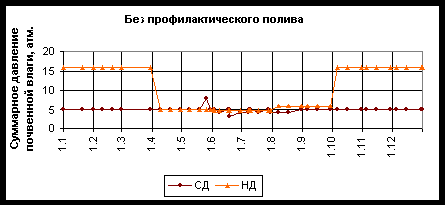
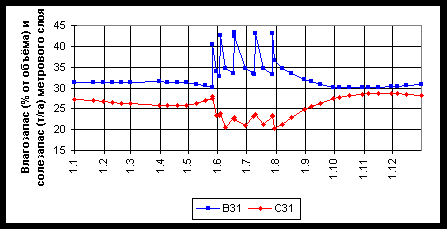
Figure
1. Predicted regimes of moisture and salts without spring and autumn
moisture-charging
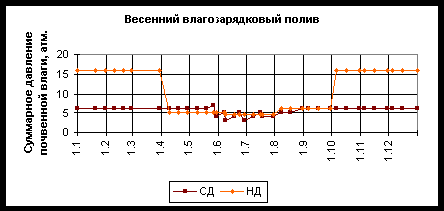
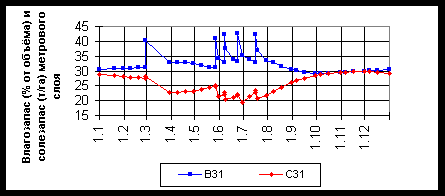
Figure
2. Predicted regimes of moisture and salts at spring moisture-charging
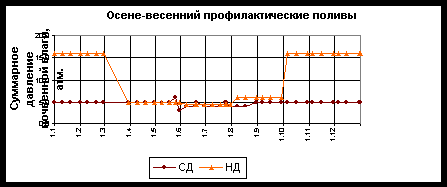
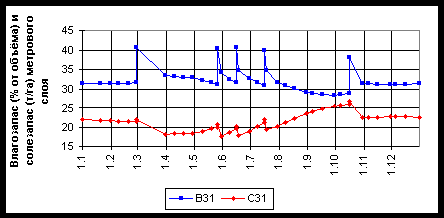
Figure
3. Predicted regimes of moisture and salts at spring and autumn moisture-charging
(Graphical symbols on the graphs: MR1, SR1 - moisture reserve and
salt reserve of the soil dead layer; DP - design pressure and NP -
normative pressure of soil moisture).
As
one can see on figures 1-3 and tables 1 and 3, both spring and autumn
prophylactic irrigation enable reducing number of vegetation irrigation
without violating agrotechnical requirements recommended for a vegetation
period thanks, mostly, to water supplied during non-vegetation period
and decrease of soil solution concentration as a result of this. Application
of both spring and autumn prophylactic irrigation simultaneously results
in even higher effect in reducing vegetation irrigation rates.
Table
1. Forecast results on water need to ensure agrotechnical requirements
for loamy soils at diverse terms of prophylactic irrigation.
Terms
of carrying out of prophylactic irrigation (PI)
|
Groundwater mineralization:
|
|
C
= 3.0 g/l
|
C
= 20 g/l
|
|
Mp
|
Mv
|
Mg
|
Mv/Mg
|
Mp
|
Mv
|
Mg
|
Mv/Mg
|
|
Under
automorphic regime
|
Without
PI
|
0,0
|
4,0
|
4,0
|
1,00
|
0,0
|
4,0
|
4,0
|
1,00
|
At
spring PI
|
1,0
|
3,0
|
4,0
|
0,75
|
1,0
|
3,0
|
4,0
|
0,75
|
At
autumn PI
|
1,0
|
3,0
|
4,0
|
0,75
|
1,0
|
3,0
|
4,0
|
0,75
|
At
spring and autumn PI
|
2,0
|
2,0
|
4,0
|
0,50
|
2,0
|
2,0
|
4,0
|
0,50
|
|
Under
semihydromorphic regime
|
Without
PI
|
0,0
|
4,0
|
4,0
|
1,00
|
0,0
|
4,7
|
4,7
|
1,00
|
At
spring PI
|
1,0
|
3,0
|
4,0
|
0,75
|
1,0
|
4,0
|
5,0
|
0,80
|
At
autumn PI
|
1,0
|
3,0
|
4,0
|
0,75
|
1,0
|
3,7
|
4,7
|
0,79
|
At
spring and autumn PI
|
2,0
|
1,6
|
3,6
|
0,44
|
2,0
|
4,0
|
5,0
|
0,80
|
|
Under
hydromorphic regime
|
Without
PI
|
0,0
|
5,0
|
5,0
|
1,00
|
0,0
|
5,6
|
5,6
|
1,00
|
At
spring PI
|
1,0
|
4,0
|
5,0
|
0,80
|
1,0
|
4,0
|
5,0
|
0,80
|
At
autumn PI
|
1,0
|
3,7
|
4,7
|
0,79
|
1,0
|
3,7
|
4,7
|
0,79
|
At
spring and autumn PI
|
2,0
|
3,3
|
5,3
|
0,62
|
2,0
|
3,3
|
5,3
|
0,62
|
Table
2. Forecast results on water need to ensure agrotechnical requirements
for loamy soils at diverse rates and terms of prophylactic irrigation
for hydromorphic conditions at groundwater mineralization of C = 20
g/l.
|
Spring
prophylactic irrigation.
|
Autumn
prophylactic irrigation.
|
|
Mp
|
Mv
|
Mg
|
Mv/Mg
|
Mp
|
Mv
|
Mg
|
Mv/Mg
|
|
1,0
|
4,5
|
5,5
|
0,82
|
1,0
|
3,7
|
4,7
|
0,79
|
|
2,0
|
3,7
|
5,7
|
0,65
|
2,0
|
3,0
|
5,0
|
0,60
|
|
3,0
|
3,0
|
6,0
|
0,50
|
3,0
|
2,3
|
5,3
|
0,43
|
|
4,0
|
2,8
|
6,8
|
0,41
|
4,0
|
2,0
|
6,0
|
0,33
|
|
5,0
|
2,0
|
7,0
|
0,29
|
5,0
|
1,5
|
6,5
|
0,23
|
Table
3. Forecast results on water need to ensure agrotechnical requirements
for loamy-sand soils at diverse terms of prophylactic irrigation.
|
Terms
of carrying out of prophylactic irrigation (PI)
|
Groundwater
mineralization:
|
|
я=3.0
g/l
|
я=20
g/l
|
|
лp
|
лv
|
лg
|
лv/лg
|
лp
|
лv
|
лg
|
лv/лg
|
|
Under
automorphic regime
|
Without
PI
|
0,0
|
3,8
|
3,8
|
1,00
|
0,0
|
4,8
|
4,8
|
1,00
|
At
spring PI
|
1,0
|
2,9
|
3,9
|
0,74
|
1,0
|
3,8
|
4,8
|
0,79
|
At
autumn PI
|
1,0
|
2,7
|
3,7
|
0,73
|
1,0
|
3,8
|
4,8
|
0,79
|
At
spring and autumn PI
|
2,0
|
1,9
|
3,9
|
0,49
|
2,0
|
2,8
|
4,8
|
0,58
|
|
Under
semihydromorphic regime
|
Without
PI
|
0,0
|
7,6
|
7,6
|
1,00
|
0,0
|
8,3
|
8,3
|
1,00
|
At
spring PI
|
1,0
|
6,3
|
7,3
|
0,86
|
1,0
|
7,3
|
8,3
|
0,88
|
At
autumn PI
|
1,0
|
6,2
|
7,2
|
0,86
|
1,0
|
7,0
|
8,0
|
0,88
|
At
spring and autumn PI
|
2,0
|
4,8
|
6,8
|
0,71
|
2,0
|
6,0
|
8,0
|
0,75
|
|
Under
hydromorphic regime
|
Without
PI
|
0,0
|
8,8
|
8,8
|
1,00
|
0,0
|
9,5
|
9,5
|
1,00
|
At
spring PI
|
1,0
|
8,0
|
9,0
|
0,89
|
1,0
|
8,6
|
9,6
|
0,90
|
At
autumn PI
|
1,0
|
8,1
|
9,1
|
0,89
|
1,0
|
8,6
|
9,6
|
0,90
|
At
spring and autumn PI
|
2,0
|
7,0
|
9,0
|
0,78
|
2,0
|
7,6
|
9,6
|
0,79
|
These
forecasts allow unambiguously drawing a number of conclusions:
- there are several possible alternative scenarios of water allocation
over a year, at which moisture and salts regime does not exceed the
limits of agrotechnical requirements;
- conduction of prophylactic irrigation in all considered cases proved
to be efficient in respect to water saving in a vegetation period;
- on lands with close fresh groundwater, this method results in somewhat
lower effect than on hydromorphic soils with mineralized groundwater;
- increase of prophylactic irrigation rates to some reasonable limit
(table 2) gives certain positive effect in water saving in vegetation
period, but one should remember that, in practice, in order to supply
net-field rate of 3.0-4.0 thousand m3/ha, nearly twice water amount
is required (gross-field), not to mention the rate in system head
that will redouble owing to losses to filtration from canals.
In addition to the methods have been considered, they certainly should
use everywhere known-to-farmers methods of closing moisture by tallage
of soil upper layer, and it is advisable after every irrigation and
even heavy rain, right up to closure of the plant cover down on soil
surface, when evaporation part from the surface becomes inessential.
Terms of prophylactic irrigation conduction, depending on climatic
conditions of a certain region, have to vary. So, in the south zones,
where moisture of autumn irrigation keeps badly to vegetation beginning,
early spring irrigation is more effective. In the north zones, where
winter atmospheric precipitation strengthens leaching effect, late
autumn prophylactic irrigation is more efficient. As to the central
zone, time of carrying out of prophylactic irrigation (spring or autumn)
is of little importance.
Thus, the suggested methods can substantially help in optimal use
of the water resources discharged during a non-vegetation period from
reservoirs for power generation purposes.
References
1. Morozov A.N., Zlotnik V.A. Assessment of high-mineralized water
usability for cotton irrigation. - Scientific works collection of
the SANIIRI (Central Asian Research Institute of Irrigation) and Sredazgiprovodkhlopok
(Central Asian State Design Institute of Cotton) Institutes, Tashkent,
1983, pp.80-90.
2. яampbell R. B., Bower C. A., Richards L. A., Change of electrical
conductivity with temperature and the relation of osmotic pressure
to electrical conductivity and ion concentration for soil extracts,
Proc. Soil Sci. Am., 13, 1949 p.66-69.
3. R,Sleycher. Plants water regime. Moscow: "Mir", 1970,
pp.365.
4. K.A.Black. Plant and soil. Moscow: "Kolos", 1973, pp.503.
5. Theory of soil salinization and desalinization processes. Alma-ata:
"Nauka", 1981, 296 p.
6. Ryjkov S.N. Development and crop capacity of cotton under various
soil solution concentration. - Collection of mineralized water use
for irrigation. Moscow: "Kolos", 1973, pp.26-45.
How to get in touch with us?
Return
to the main page
|

